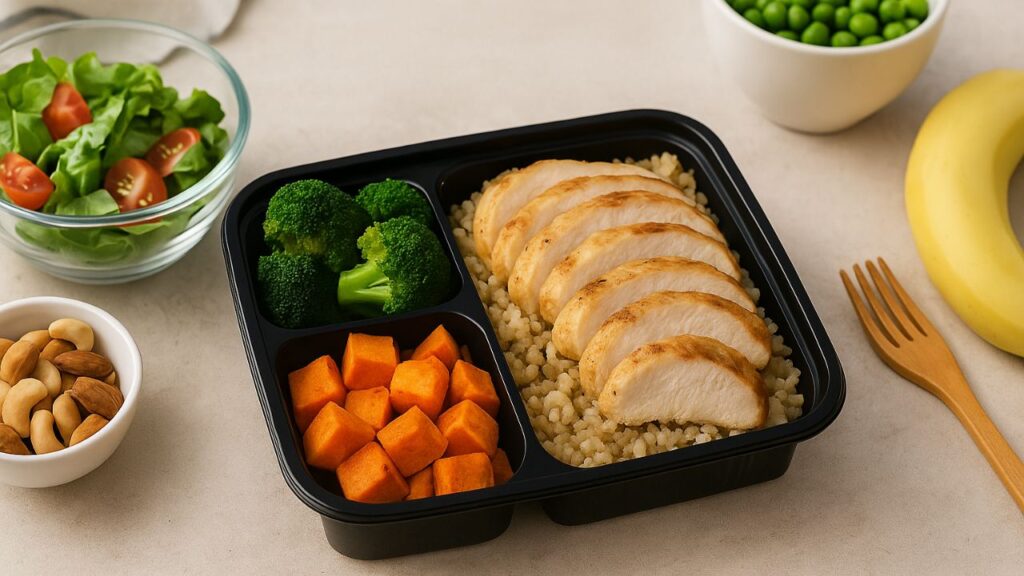
Meal prepping doesn’t have to mean spending hours in the kitchen. With high-quality ready-to-eat (RTE) meals, you can combine convenience with nutrition, saving time without sacrificing health. By choosing meals built on balanced macronutrients, incorporating local and seasonal ingredients, and skipping unnecessary fillers, you’ll fuel your body wisely and enjoy every bite. Here’s how to do it right.
Why Balanced Macros Matter
A well-structured meal packs the right blend of protein, carbohydrates, and healthy fats, the three macronutrients your body needs to function optimally. Protein supports muscle repair and satiety; complex carbs provide steady energy; healthy fats support brain function and nutrient absorption.
Studies highlight the importance of balanced meals in managing blood sugar and maintaining energy levels throughout the day. Harvard Health notes that meals with around 30 g of protein, 40–50 g of complex carbs, and a source of healthy fat can help support weight control and steady energy levels. Ready-to-eat meals with this balance let you stay on track without measuring every component yourself.
Tip: Look for RTE options listing macro breakdowns on the label. If available, aim for meals with:
- 25–35 g protein
- 30–50 g carbs (preferably from whole grains or vegetables)
- 10–15 g good fats (like avocado oil, nuts, or olive oil)
Embrace Local and Seasonal Ingredients
Seasonal produce isn’t just trendy, it’s more nutritious and flavorful. The USDA shows that vegetables and fruits picked at peak ripeness retain more vitamins and minerals than those harvested early for shipping. Plus, seasonal food often has a smaller carbon footprint and supports local farmers, making it a sustainable choice.
When evaluating RTE meals, look for options spotlighting ingredients such as:
- Summer: zucchini, corn, berries
- Fall: squash, apples, root vegetables
- Winter: kale, citrus, squash
These ingredients offer vibrant color, bold flavor, and nutritional richness—without the “bro science” hype. Adding seasonal produce helps keep your meals exciting and aligned with real, whole-food nutrition.
RTE Meal Planning: Practical Tips
- Stock strategically. Stock enough meals for busy days and a few fresh foods like salad or fruit when you’re in the mood for something crisp.
- Mix and match macro profiles. If your first meal leans heavily on carbs, opt for a higher-protein RTE option next time.
- Revamp your meals. Add a handful of chopped veggies, a splash of olive oil, or a fresh herb garnish to amp up nutrition and flavor.
- Read labels for added ingredients. Watch for excess sodium, added sugars, or ambiguous ingredients. A good rule of thumb: ingredients you recognize (like quinoa, sweet potato, olive oil) are better than vague fillers like “flavoring” or “textured vegetable protein.”
- Repurpose leftovers. Turn an RTE entrée into a hearty salad base, wrap filling, or stir-fry starter. It cuts waste and keeps meals interesting.
Busting Macro Myths: Science-Backed Facts
“Bro science” often simplifies macros to “more protein means bigger muscles.” But real science says balance is key. According to Healthline, going overboard on protein doesn’t guarantee better results, when your body receives more than it needs, the excess is stored as fat or excreted. Similarly, categorizing all carbs as “bad” ignores their vital role in energy and fiber intake.
Instead, prioritize whole-food carb sources like sweet potatoes, oatmeal, or legumes, and healthy fats like olive oil, nuts, and seeds, in moderate amounts. An RTE meal that hits all three macros and avoids misleading labels like “keto-approved” without transparent macros will serve your health better in the long run.
Wrap-Up: Smart, Seasonal, Science-Based Meal Prep
Meal prepping smart with ready-to-eat meals doesn’t mean giving up control or quality. By choosing balanced macros, focusing on local and seasonal ingredients, and staying evidence-based (thanks, Harvard and Healthline), you can enjoy food that respects both your body and your schedule.
Start by checking meal labels, then try simple upgrades like tossing in seasonal veggies or a handful of nuts. Rotate between macro profiles to keep your nutrition well-rounded, and remember: a healthy plate is about balance, not extremes.






